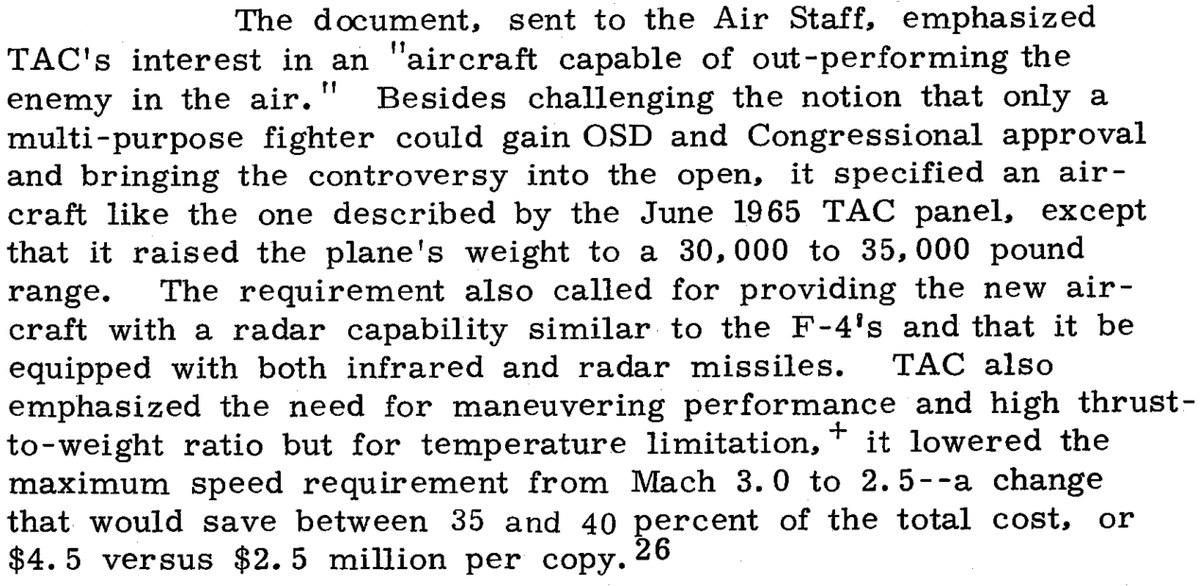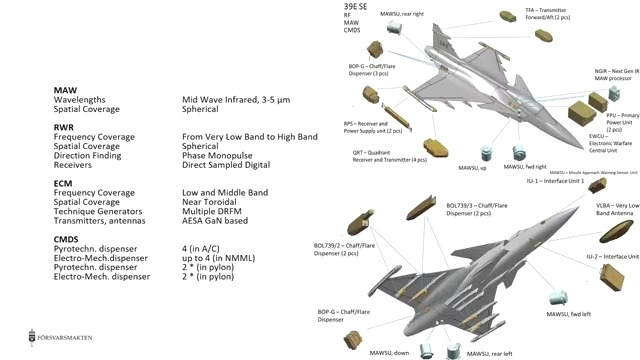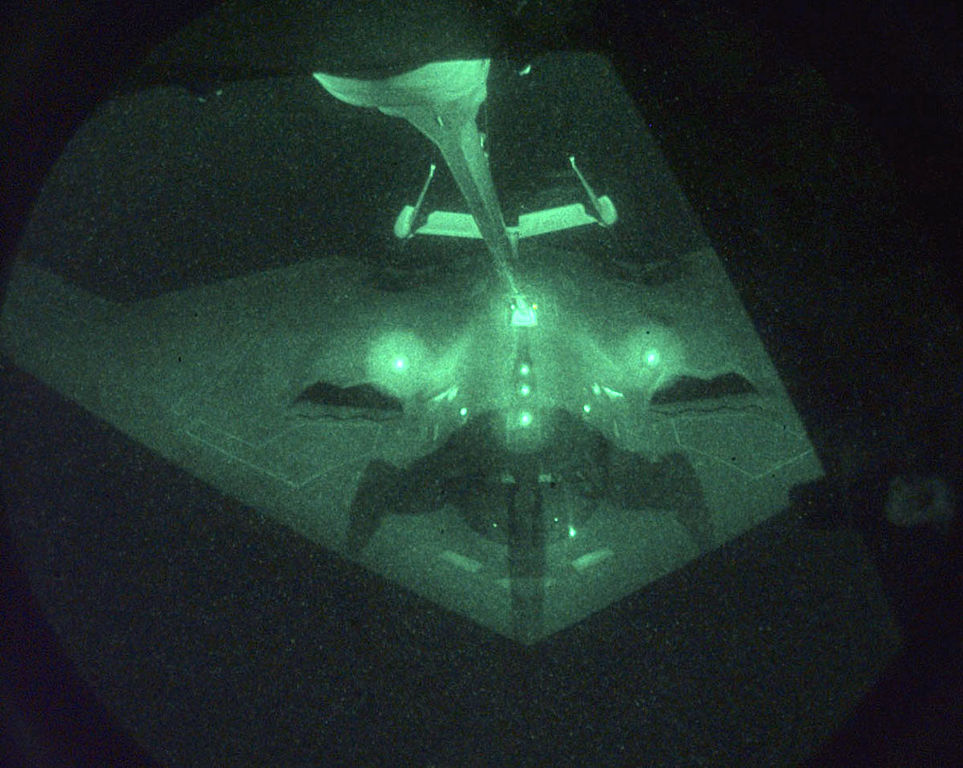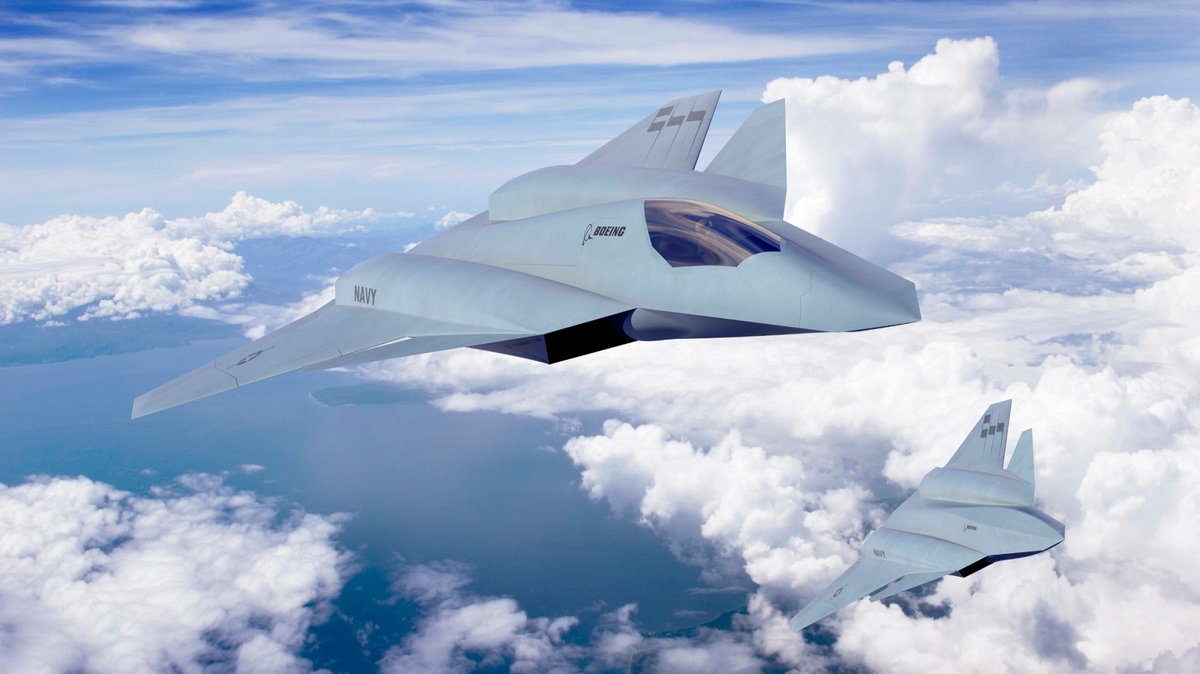Over the years, much has been discussed about the development of the F-15 Eagle. A recurring theme in this is the importance of the MiG-25 in the development of the Eagle.
History, however, reflects a complete lack of influence over the F-15 program. 🧵

History, however, reflects a complete lack of influence over the F-15 program. 🧵


The first place to start is most definitely with the deficiency that generated the requirement for what would become the F-X program.
Just after the adoption of the F-4 and F-111, there was a concern amongst some of the USAF staff that they would be inadequate for air superiority. However, they were unable to make a convincing case, and were often shoved out of the picture by higher-ups or McNamara. 







The solution began with re-assessing the entire force structure of the USAF. This was done by a study conducted by Lt. Col. John W. Bohn, Jr., which generated the concept of the "High/Low" mix of aircraft that would define USAF force structure for decades to come. 

The F-X program started out as a complete mess. To avoid being shut down, the working group disguised the F-X as a multi-role fighter.
It wouldn't be long before the effort moved back to air superiority, though an STOL proposal was also tossed around for a time.

It wouldn't be long before the effort moved back to air superiority, though an STOL proposal was also tossed around for a time.


By October 1965, however, the tide had turned. General Gabriel Disosway, the new head of Tactical Air Command, issued a document stating TAC's interest in an air superiority fighter. This was still far lighter than what would come out of the F-X program, but it was a start. 

However, once again, the USAF and contractors would become distracted by the multi-role requirement, and the initial Request for Proposals(RFP) in 1965 turned up what could be charitably described as "More F-111s." 





One of the big breakthroughs came with Major John Boyd's Energy Maneuverability theory. This was a concept known to engineers and pilots alike, but E-M created a new common language between the two, allowing for effective communication. 



Thanks to Boyd's efforts, a better understanding of what must be accomplished with F-X was beginning to form. This was higher performance, higher weight, lower speed, and focused on maneuvering performance up to Mach 1.6 and 30,000 feet. 

Some of you may remember this chart from a previous thread! This was from a Northrop study, but almost all who were focused on maneuvering performance had an understanding that Mach 1.6 was about the top end of what was practical. 

Also in 1967, the USAF was becoming more wary of Soviet tactical fighters that could prove deeply problematic for the F-4 to handle, leaving the US potentially vulnerable in a European conflict. 

This is where it is often cited that the USAF was afraid of the MiG-25. However, the fighters mentioned as a threat are the SU-7 and what is likely the SU-15. Not the MiG-25. 



The potential requirements for the next tactical fighter reflected this. This statement here would become the template for the F-15, save for the variable-sweep wings. 

The influence of the MiG-25, if any, comes after that.
In February 1968, Gen. Disosway moved to head off the possibility of the Navy's F-14 becoming a joint program, knowing that they could produce a better air superiority fighter.

In February 1968, Gen. Disosway moved to head off the possibility of the Navy's F-14 becoming a joint program, knowing that they could produce a better air superiority fighter.


The primary concern here was speed. This requirement was reduced back to the original value of Mach 2.3 sustained with a 2.5 sprint speed, as the Mach 2.7 speed would greatly impact maneuver performance through added weight, range, and cost. 

So where did the belief that the F-15 was designed to counter the MiG-25 come from? From everything that I can find, the media.
The USAF understood the MiG-25 as an interceptor, and included the powerful radar and Sparrow armament to counter a possible MiG-25 threat. The public, however, had a skewed idea of the 25's performance, and thus believed that it was a greater threat. 



You'll note that in response to a question about the MiG-25's threat, the answer referenced the MiG-21 and MiG-23. We knew that these two fighters, which made up a large portion of the Soviet Air Forces, were a far greater threat than the PVO's MiG-25.
This should thoroughly put to bed the myth that the Foxbat had a significant influence on the development of the F-15. It had a significant influence on the internal politics in the DoD that allowed for the development of the F-15, but it played a minor role otherwise.
Though that could be the end of this thread, I want to continue discussing the F-15, because there are some other funny things to touch on, including the myth that the F-15 was designed solely for air-to-air. But that comes later. First, requirements: 





Three major contractors were selected to deliver proposals. Fairchild-Hiller (Republic division), North American, and McDonnell-Douglas. 







The Pratt & Whitney F100 engine was designed as a joint program between the USAF and USN, with the "common cored" F401 to power the F-14 after the F100's introduction on the F-15. These both would face severe technical problems and the F401 would be cancelled. 





The radar, though, was a story of success. The Westinghouse proposal was a digital version of the AWG-10 radar used in the F-4J Phantom, which, while effective, was relatively lower range and less advanced. 



The Hughes proposal, what would become APG-63, was built off of what had been learned developing the ASG-18 and AWG-9 radars, but used a fundamentally different backend. It was fully digital, lightweight, and extremely easy to maintain. 







During the testing phase, the Hughes proposal was unreliable, and often gave false returns or was down for maintenance. However, when it worked, it far outperformed the Westinghouse unit, and would provide a significant leap forward in fighter radars for the USAF. 

In the end, its reliability would significantly increase overtime, and be nearly three times that of the F-4E's APQ-120 by 1985. Peak performance could be nearly 100 mean flight hours between failures! 



Finally, turning back to the initial concept of the F-15, an air-superiority-only fighter, we come to the final contradiction. The air-to-ground capabilities of the F-15. 

Though the pitch to Congress was for a solely air-superiority-focused design, there was an understanding that air-to-ground should be silently considered in the design. Even the official histories fail to adequately mention the consideration of A2G in the program.
Though only referenced in passing until after the program had been completed and the F-15 had been adopted, the air-to-ground consideration appears to have never gone away. Note the several mentions of "air-to-ground". 

Additionally, as soon as the F-15 had been adopted, advertising for it began to shift towards its multi-role potential. 







This is even shown in USAF documents, with the F-15C showing extensive air-to-ground and guided munition carriage, despite the lack of this capability being used often in service. 

This hopefully should help dispel some of the myths surrounding the F-15' development. The MiG-25, despite being a threat, was not considered an air superiority fighter and thus had little influence on the F-15, and there was, most definitely, a pound for air-to-ground. 

As requested @Lantirn40K
@actualjib
@TomcatJunkie
@SpockNC
@Thatdude2531
@ond144
@VLO225
@taiwaneseprick
@RokkerBoyy
@peck_oh
@steeljawscribe
@KiranPfitzner
@whatismoo
@VLS_Appreciator
@Doha104p3
@BaA43A3aHY
@StrokeNdistance
@EricWelch42
@coldfoot666
@IrisLibreism
@IBMninja
@actualjib
@TomcatJunkie
@SpockNC
@Thatdude2531
@ond144
@VLO225
@taiwaneseprick
@RokkerBoyy
@peck_oh
@steeljawscribe
@KiranPfitzner
@whatismoo
@VLS_Appreciator
@Doha104p3
@BaA43A3aHY
@StrokeNdistance
@EricWelch42
@coldfoot666
@IrisLibreism
@IBMninja
@Tato_the_Jew I guess buddy lased? Maybe there were plans for a TGP that fell through? maybe a typo? idk
• • •
Missing some Tweet in this thread? You can try to
force a refresh



























